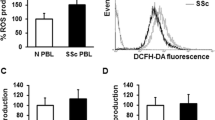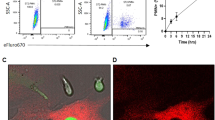Abstract
Severe, malignant osteopetrosis is a disease characterized by osteoclasts that fail to resorb bone. Serious defects in the ability of white blood cells to eradicate infectious agents confound the clinical course. Defective superoxide generation by neutrophils, monocytes, and lymphocytes contributes to this inability to fight infection. To elucidate the mechanisms resulting in the defective superoxide generation observed in osteopetrotic leukocytes, gene expression, translocation, and phosphorylation of the major components that form the fimctional NADPH oxidase complex were studied in transformed B-lymphocytes. The expression of the p47 subunit of NADPH oxidase was reduced in B-lymphocytes collected from osteopetrotic patients compared to those from controls. Phosphorylation and translocation of p47 to the cell membrane after PMA stimulation was similar in B-lymphocytes from both patients and normal controls. However, total amount of p47 phosphorylation and translocation was reduced in patient samples. This was further supported by the experiment using p47 antisense oligonucleotide. The other major components of the oxidase (p91, p22, p67) were found to be present at normal levels. Thus, the reduction in p47 expression results in reduced ability to assemble a ftmctional NADPH oxidase complex at the membrane of lymphocytes from osteopetrotic patients. This defect translates into reduced superoxide generation and an increased propensity for infection.
Similar content being viewed by others
References
Felix R, Hofstetter W, Cecchini MG: Recent developments in the understanding of the pathophysiology of osteopetrosis. Eur J Endocrinology 134: 143–156, 1996
Key LL, Ries WL: Osteopetrosis. In: J.P. Bilezikian, L.G. Raisz, G.A. Rodan (eds). Principles of bone biology. Academic Press, San Diego, 1996, pp 941–950
Seifert MF, Popoff SN, Jackson ME, MacKay CA, Cielinski M, Marks Jr. SC: Experimental studies of osteopetrosis in laboratory animals. Clin Orthop 294: 23–27, 1993
Marks SC Jr: Osteopetrosis – multiple pathway for the interception of osteoclast function. Appl Pathol 5: 172–185, 1987
Key LL, Ries WL: Osteopetrosis. The pharmaco-physiologic basis of therapy. Clin Orthop 294: 85–89, 1993
Reeves JD, Augus CS, Hwnbert JR, Weston WL: Host defense in infantile osteopetrosis. Pediatrics 64: 202–206, 1979
Beard IR, Key LL, Newburger PE, Ezekowitz AB, Arceci R, Miller B, Proto P, Ryan T, Anast C, Simons ER: Neutrophil defect associated with malignant infantile osteopetrosis. J Lab Clin Med 108: 498–505, 1986
Ezekowitz RA, Dinauer MC, Jaffe HS, Orkin SH, Newberger PE: Partial correction of the phagocyte defect in patients with X-linked chronic granulomatous disease by subcutaneous interferon gamma. N Engl J Med 319: 146–151, 1988
Popoff SN, Marks SC, Jr: The heterogeneity of the osteopetroses reflects the diversity of the cellular influences during skeletal development. Bone 17: 437–445, 1995
Maly FE, Cross AR, Jones OT, Wolf Vorbeck G, Walker C, DeWeck AL: The superoxide generating system of B cell line: Structural homology with the phagocytic oxidase and triggering via surface Ig. J Immunol 140: 2334–2339, 1988
Maly FE, Nakamura M, Gauchat A, Urwyler C, Walker C, Dahinden CA, Cross Ar, Jones OT, DeWeck AL: Superoxide dependent nitroblue tetrazolium reduction and expression of cytochrome b245 components by human B-lymphocytes and B-cell line. J Immunol 142: 1260–1267, 1990
Thrasher A, Chetty M, Casimir C, Segal AW: Restoration of superoxide generation to a chronic granulomatous disease-derived B-cell line by retrovirus mediated gene transfer. Blood 80: 1125–1128, 1992
Morel F, Doussiere J, Vignais PV: The superoxide-generating oxidase of phagocytic cells, physiological, molecular and pathological aspects. Eur J Biochem 201: 523–528, 1991
Segal AW, Abo A: The biochemical basis of the NADPH oxidase of phagocytes. Trends Biol Sci 18: 43–47, 1993
O'Donnell VB, Tew DG, Jones OTG, England PJ: Studies on the inhibitory mechanism of iodonium compounds with special reference to neutrophil NADPH oxidase. Biochem J 290: 41–47, 1993
Doyle, A: Establishment of lymphoblastoid cell line. In: J.W. Pollard and J.M. Walker (eds). Methods in molecular biology, Vol. 5, animal cell culture, Humana Press, New Jersey, 1990, pp 43–47
Markert M, Andrews PC, Babior BM: Measurement of O2-production by human neutrophils. The preparation and assay of NADPH oxidase-containing particles from human neutrophils. Methods Enzymol 105: 358–378, 1984
Yang S, Zhang YZ, Ries VvL, Key LL: Characterization of M-CSF and its receptor in microphthalmic mice. Exp Hematol 23: 126–132, 1995
Parkos CA, Dinauer MC, Walker LE, Allen RA, Jesaitis AJ, Orkin SH: Primary structure and unique expression of the 22-kilodolton light chain of human neutrophil cytochrome b. Proc Natl Acad Sci USA 85: 3319–3323, 1988
Lomax KJ, Leto TL, Nunoi H, Gallin JI, Malech HL: Recombinant 47-Kilodalton cytosol factor restores NADPH oxidase in chronic granulomatous disease. Science 245: 409–412, 1989
Leto TL, Lomax KJ, Volpp BD, Nunoi H, Sechler JM, Nauseef WM, Clark RA, Gallin JI, Malech HL: Cloning of a 67-KD neutrophil oxidase factor with similarity to a noncatalytic region of p60c-src. Science 248: 727–730, 1990
Royer-pokora B, Kunkel LM, Monaco AP, Goff SC, Newburger PE, Baehner RL, Cole FS, Cumutte J, Orkin SH: Cloning the gene for an inherited human disorder – chronic granulomatous disease – on the basis of its chromosomal location. Nature 322: 32–35, 1986
Kramer IM, Vanderbend RL, Verhoeven AJ, Roos D: The 47-Kda protein involved in the NADPH:O2 oxidoreductase activity of human neutrophils is phosphorylated by cyclic AMP-dependent protein kinase without induction of a respiratory burst. Biochim Biophys Acta 971: 189–195, 1988
Hallett MB, Lloyds D: Neutrophil priming: The cellular signals that say ‘amber’ but not ‘green'. Immunol Today 16: 264–268, 1995
Rotrosen D, Leto TL: Phosphorylation of neutrophil 47-kDa cytosolic oxidase factor. J Biol Chem 265: 19910–19913, 1990
Skubitz KM, Goueli SA: CD31 (PECAM-1), Cdw32 (FcrRII), and Anti-HLA class I monoclonal antibodies recognize phosphotyrosinecontaining proteins on the surface of human neutrophils. J Immunol 152: 5902–5906, 1994
Leto TL, Garrett MC, Fujii H, Nunoi H. Characterization of neutrophil NADPH oxidase factors p47-phox and p67-phox from recombinant baculoviruses. J Biol Chem 266: 19812–19818, 1991
Abo A, Pick E: Purification and characterization of a third cytosolic component of the superoxide-generating NADPH oxidase of macrophages. J Biol Chem 266: 23577–23585, 1991
Zubiaga AM, Belasco JG, Greenberg ME: The nonamer UUAUUUAUU is the key AU-rich sequence motif that mediates mRNA degradation. Mol Cell Biol 15: 2219–2230, 1995
Key LL Jr., Ries WL, Taylor RG, Hays BD, Pitzer BL: Oxygen derived free radicals in osteoclasts: The specificity and location of the nitroblue tetrazolium reaction. Bone 11: 115–119, 1990
Silverton S: Osteoclast radicals. J Cell Biochem 56: 367–373, 1994
Garrett IR, Boyce BF, Oreffo RO, Bonewald L, Poser J, Mundy GR: Oxygen-derived free radicals stimulate osteoclastic bone resorption in rodent bone in vitro and in vivo. J Clin Invest 85: 632–639, 1990
Darden A, Ries WL, Wolf WC, Rodriguiz RM, Key LL: Osteoclastic superoxide production and bone resorption: Stimulation and inhibition by modulators of NADPH oxidase. J Bone Miner Res 11: 671–675, 1996
Steinbeck MJ, Appel WH, Verhoeven AJ, Kamovsky MJ: NADPHoxidase expression and in situ production of superoxide by osteoclasts actively resorbing bone. J Cell Biol 126: 765–772, 1994
Ries WL, Key LL, Rodriguiz RM: Nitroblue tetrazolium reduction and bone resorption by osteoclasts in vitro inhibited by a manganese-based superoxide dismutase mimic. J Bone Miner Res 7: 931–939, 1992
Key LL, Wolf WC, Gundberg CM, Ries WL: Superoxide and bone resorption. Bone 15: 431–436, 1994
Jackson SH, Gallin JI, Holland SM: The p47phox mouse knock-out model of chronic granulomatous disease. J Exp Med 182: 751–758, 1995
Pollock JD, Williams DA, Gifford MA, Li LL, Du X, Fisherman J, Orkin SH, Doerschuk CM, Dinauer MC: Mouse model of X-linked chronic granulomatous disease, an inherited defect in phagocyte superoxide production. Nat Genet 9: 202–209, 1995
Chambers TJ: The origin of the osteoclast. In: W.A. Peck (ed). Bone and Mineral Research. Elsevier Science Publishers, Amsterdam, 1989, pp. 1–10.
Udagawa N, Takahashi N, Akatsu H, Tanaka T, Sasaki T, Nishihara T, Koga T, Martin TJ, Suda T: Origin of osteoclasts: Mature monocytes and macrophages are capable differentiating into osteoclasts under a suitable microenviromnent prepared by bone marrow-derived stromal cells. Proc Natl Acad Sci USA 87: 7260–7265, 1990
Author information
Authors and Affiliations
Rights and permissions
About this article
Cite this article
Yang, S., Yang, S., Ries, W.L. et al. Superoxide generation in transformed B-lymphocytes from patients with severe, malignant osteopetrosis. Mol Cell Biochem 199, 15–24 (1999). https://doi.org/10.1023/A:1006990730115
Issue Date:
DOI: https://doi.org/10.1023/A:1006990730115




